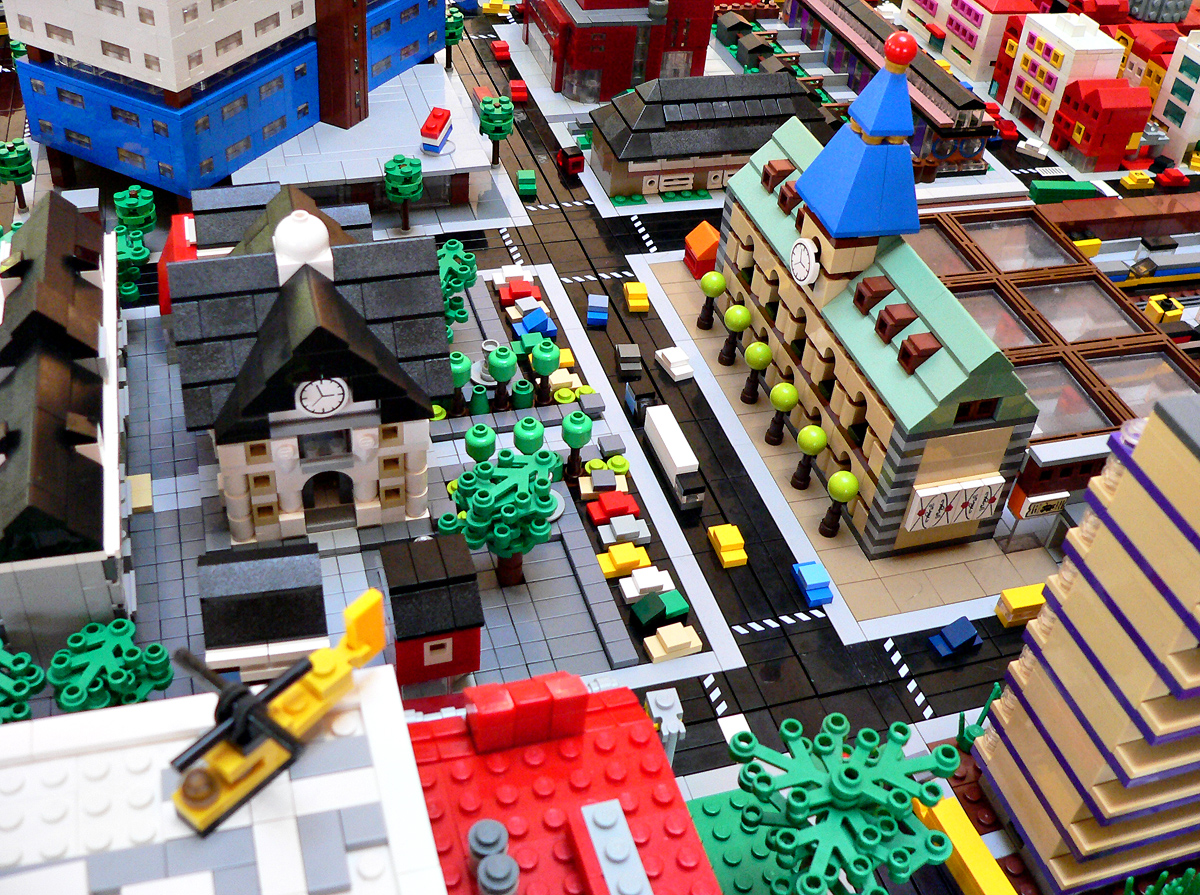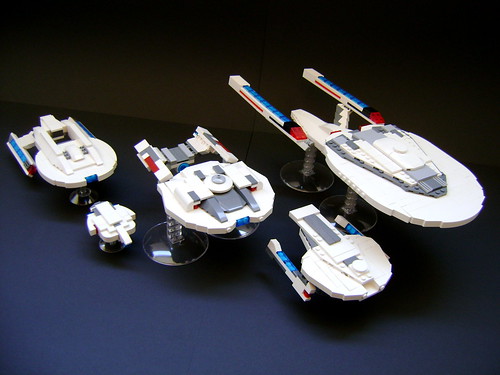One of the biggest challenges in the LEGO community is agreeing on a scale for MOCs. In the simplest case, the squat proportions of the minifigure make determining a scale for roads and cars incredibly difficult. In the extreme case, the supremely high variability in various "micro" scales makes comparing models almost impossible.
In order to remedy this problem, there have been a few efforts to create standardized scales in various class-sizes. The most important size classes are Minifig Scale, City Scale, and Micro Scale.
Minifig Scale
The most basic Minifig Scale is centered around the height of the Minifigure. A common standard in many toy systems is that a figure is 6' tall. This would make the Minifig scale 1:44. However, the minifigure is very squatly, and at 1:44, the minifigure would be almost two and a half feet wide. I prefer a scale of 1:36.5, which makes the minifigure 5' tall, and although that's somewhat short, I find it a nice balance between height and width (only (!) 1.9 feet), and also provides the advantage of each plate being 5" thick in-scale.
Another common Minifig Scale relies on the LEGO train system, also known as L-gauge. Nominally, L-gauge is 1:38 based on track width, which would make a minifigure approximately 5'2" tall. I like this scale, but it still suffers the same problem of having the minifigures be too fat. In particular, this poses a problem for seating minifigs side by side, either in a train car, or in a road car. In real life, where you can fit four people and an aisle across a train car, in L-gauge, you are lucky to get two minifigs and an aisle due to the broad hip and shoulder width, relative to height, of the minifig. If we use width as the basis for scaling, we'd find that a normal person should fit into a seat that is 17" wide. This means that a minifig would be no wider than 17" at the hips, which corresponds to a scale of 1:27, which would mean a minifig would stand no more than 3'8" tall.
In particular, this width issue causes numerous problems for road cars. To fit two minifigures side-by-side in a car, the car can't be narrower than 7 studs. At 1:44, this would make the cars 8' wide. To get a "normal" 6' wide car, you have to fall down to a scale of 1:32.5, or a minifigure that is 4'6" tall (and still incredibly fat!).
Obviously, the perfect solution for all this is for the minifigs to go on a diet! But barring that, the best solution to a definitive Minifig Scale is to play it by ear, and go with what looks best. This is a creative hobby, you know!
City Scale
The most popular city scale, and one of the first community efforts to create a standardized scale, is the Micropolis scale. The Micropolis scale is approximately 1:285, and corresponds to 7.5' between orthogonal studs. The beauty of the Micropolis system is that, apart from its unifying scale, it also provides standard dimensions for roads, city blocks, and cars. I personally love the Micropolis scale, and I find it a great scale to build anything in, from ancient Egyptian temples to space-age ships and buildings. However, there is a glaring problem with the Micropolis scale.
Many of the worlds coolest buildings are highly impractical to build in Micropolis scale. Burj Khalifa, a gorgeous skyscraper in the UAE, stands over 800m tall, which is nearly 10' in Micropolis scale, and has a footprint of nearly 3' by 3'. Humongous!
The common solution to this is to settle on a smaller scale, which is usually somewhere between 1:300 and 1:5000. LEGO has actually produced an official Burj Khalifa Architecture model, scaled at approximately 1:3250. Usually, a creator picks a scale that balances practicality with ability to display details, and produced a small collection of models in that scale. Unfortunately, there is no real city-scale standard apart from Micropolis.
Micro Scale
Though many would call Micropolis a micro-scale standard, I classify it separately as it exists to create a standard around which to build a city. To me, Micro scale deals primarily with vehicles and vessels. Of these, space is probably the most common use, especially themed recreations (like Star Wars, Star Trek, Battlestar Galactica, etc.)
Just a few years ago, there was no real standard in Micro scale space creations. Most of the time, it seemed that people would make a model, and then based on its appearance, after-the-fact decide what scale it was in. But then, LEGO created one of the coolest sets ever: the UCS Imperial Star Destroyer 10030! This set included both the venerable ISD as well as a Corellian Corvette (also known as a Rebel Blockade Runner). The best part about this is that both these models were at the same scale, approximately 1:1600, which has become known as the ISD scale. Brick Commander is probably the most well known builder in the ISD scale, with a number of fantastic models from different universes.
When it comes to over-the-top massive spacecraft, the ISD scale suffers the same problems as the Micropolis scale. But in the same vein, many AFOLs are turning towards the official UCS Super Star Destroyer (aka Executor). Given that, in universe, the Executor is 19km long, and the set is approximately 50" long, the scale is about 1:15,000, which has become known as the SSD scale. Unfortunately, the ISD that LEGO included with the SSD is three studs too short to be in-scale, but that is easily remedied with a little bit of MOCing. SSD scale allows large starships, such as the original ISD, to be built bite-sized, which means that incredibly massive starships, such as the Borg Cube, the Voth City Ship, and the Lexx, can actually be built with a reasonable footprint. (This website provides a nice pictorial scale reference for ships.)
Of course, some people do use their own scales, and often times the micro scale exists somewhere between 1:5000 and 1:10,000, which is a good mix of size and detailing for largish ships (such as the ISD or Galaxy-class).



No comments:
Post a Comment